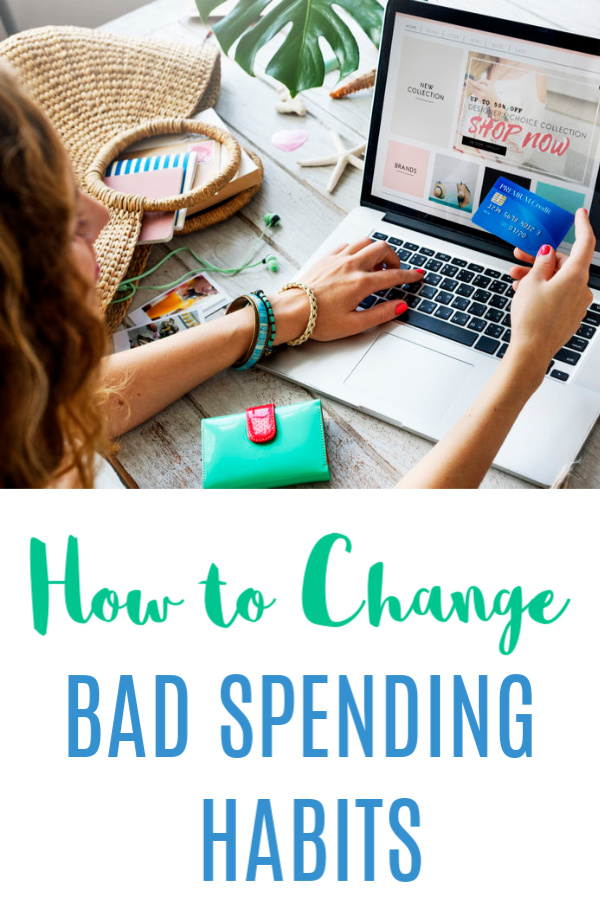Shopping is a must-do activity, but it can also be a way to pass the time, entertain yourself, or it can be a way of masking emotional distress. If you’re trying to stick to a budget, one thing that can help is to identify bad spending habits and work to correct them.

It’s easy to fall into bad shopping habits that can be of no real benefit. These can escalate into major problems that affect our finances and even your emotional and physical well-being. To change any bad habit you need to identify what habits you consider are bad shopping habits and how you can change them.
What are Bad Spending Habits?
Bad habits may include overspending, putting too much on credit, buying too much or buying thing that are not necessary, buying what you do not need or buying things on impulse. You may be spending too much time shopping. Or, you may have developed an obsession with shopping turning it into an irrational and irresistible impulse. Something you bought may give you some gratification when buying it but not long lasting satisfaction.
Excuses for Over-Spending
Shopping is a necessary part of life. We have to buy food on a regular basis to keep ourselves well fed with fresh meat, fruits and vegetables. We shop for clothes and footwear as our need arises or our desire to keep up with fashion and trends. We shop because we feel obligated to bring nice gifts to a birthday party. We buy furniture and household goods when we move, when an item becomes worn out, or when we want to freshen up our living space. When you’re sticking to a budget, these purchases should be accounted for in your monthly spending plan. If there isn’t room in the budget for a new couch or new clothes for the season, visit thrift stores to find something more affordable.

Try the only budget plan you’ll ever need.
Red Flag: Shopping Because You’re Bored
The mall can be a fun place to visit. You can get exercise while walking around, and the food court is always a great place to snag a sweet treat. If money is tight, you may have to avoid using the mall as a form of entertainment.
Think about why you “need to shop”. Is it a way to relieve stress? Are you shopping because it makes you feel happy, cheerful or content? Spending money is fun at the time, but people often suffer from “buyer’s remorse”: a feeling of regret after spending money that they don’t have or racking up credit card debt.
Check out these budgeting tips to keep you on track.

If your shopping habits are causing you unnecessary stress and financial strain you need to do something about it. Once you have identified the bad habits you want to change and understand how these changes will positively impact on your life you are well on the way to implementing these important life changing patterns.
Strategy #1: Make a List
When shopping for your weekly food bill consider making a list of items you need to purchase before you go to the shops. Then stay as close as practical within the shopping list. Never shop when you are hungry as you will buy more than you need.
Check out how to organize your meal plan like a pro.

Strategy #2: Think Long-Term
What ever you shop for consider your budget, the reason you are buying and its practicability. Will you still be excited about this purchase in a week? A month? A year? Remember that fashions and trends come and go and if you have no real need to buy an item consider how it will impact you financially. More often than not something in your wardrobe will fit an informal occasion or situation. Always check what you already have at home or even what you may be able to borrow from a friend or family member before you venture out to the shops.
Strategy #3: No More Credit Cards
Nobody likes this one, but it is the most proven way to cut back on spending. You don’t have to cut up the credit cards. But do stop using them to pay for things you can’t afford. Do it the old fashioned way – save up, and buy nice things in cash. We stopped using credit cards about 2 years ago and it is such a relief to not have the pressure of credit card debt and overwhelming payments hanging over our heads.
Strategy #4: Wait
You can fight the habit to buy on impulse by giving yourself a cooling-off period before buying something. When there is a really big purchase that I want to make, I add it to my Amazon cart or write it on the calendar. I give myself 30 days to think about it. After 30 days if I still think this is something I can’t live without, then I can buy it. Otherwise, I make do with what I have on hand.
Watch out for marketing ploys. Sellers will try to create a sense of urgency so that you have to buy now. People get pressured into spending right away by offers like “2 days only” sales or discounts “for a limited time”. Don’t let these trick you into blowing your budget!

Strategy #5: Run from Temptation!
No one “accidentally” finds themselves at Target. You go there fully aware that you’ll probably end up in the check-out lane, appalled at how much you spent when you just went in “for one thing”. If you know you can’t go to Target without spending $120, then don’t go to Target! Get what you need on Amazon, send in your hubby, or find it at another store where you won’t be tempted to buy all the things. Do yourself a favor to avoid spending money you don’t have: know your weaknesses, admit to yourself the stores you always spend too much money in, and stay away from them.
Learning to quit bad spending habits isn’t easy. It helps to remind yourself of your financial goals. Be grateful for what you have. Find other ways to experience inner joy and satisfaction. Don’t put yourself under pressure to buy things that you can’t afford or will regret later. Bad habits are meant to be broken so that our lives become more significant and meaningful.
